Long long ago, the Great King Alexander came to the Indus Valley to conquer it. From Indus to Beas, he spread his kingdom before turning back. He went home but left behind a few of his clansmen who settled in Ladakh. These men made this their home and lived a peaceful life in the Indus Valley. Unknown to many, they still live on as the last Aryan village in India. You can find them at Dahanu or the Dah Hanu Villages in Ladakh.
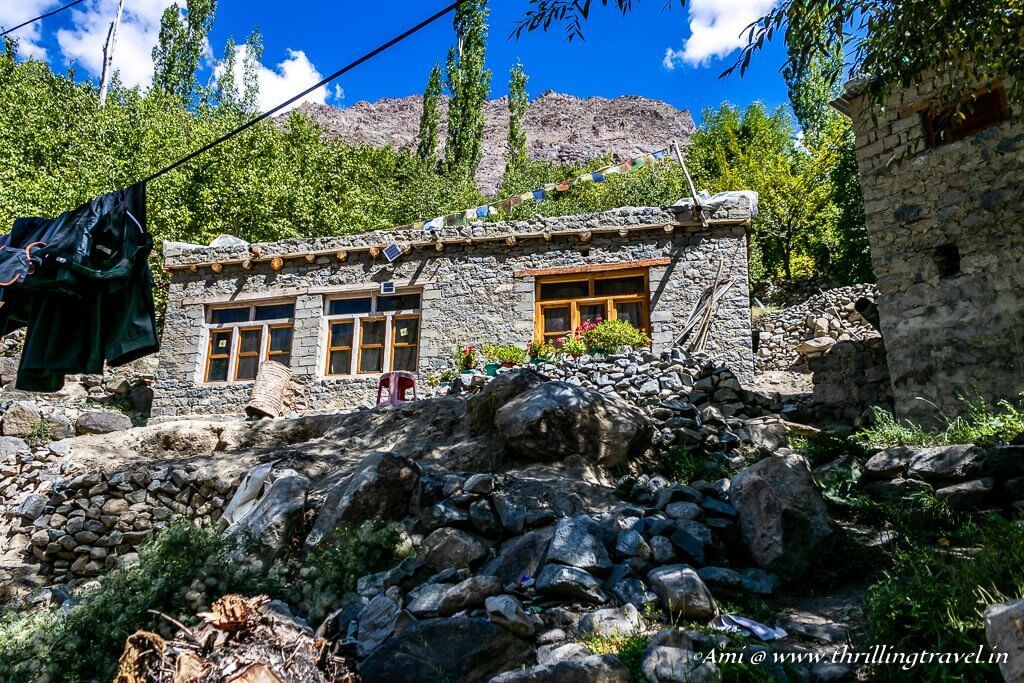
Lost treasures, Lost kingdoms and in this case a lost village and tribe. How could I not visit this, especially since I discovered that it is ahead of Alchi, close to Kargil. With my Ladakh Inner Line Permit in hand, I went ahead to meet the inhabitants of the Last Aryan Village. Questions filled my mind – Did they still have any relics of Alexander? How old was the oldest person? Did they practice their ancient traditions? How many people were there? And so much more. Answers to these lie in my visit to the Dahanu Village in Ladakh.
Contents
- 1 The Last Aryan Village in Ladakh
- 2 Getting to Dahanu Villages in Ladakh
- 3 Meeting our first resident of Dah Village
- 4 Chat over the Apricots
- 5 Brokpa Food & Life
- 6 Aryan Festivals of Dahanu Village in Ladakh
- 7 A traditional Aryan attire
- 8 Escape during the Indo-Pak War
- 9 A Tea Invitation by the Aryan Lady
- 10 How to visit the Aryan Village in Dahanu, Ladakh?
- 11 Travel Tips
The Last Aryan Village in Ladakh
There is actually a cluster of 5 villages close to the Indo-Pak border in Ladakh. Dahanu actually represents two of these villages – Dah and Hanu. It is possible to visit the Aryan tribes only in these two villages. The rest of them – Sanit, Bheema, and Garkon are actually out of bounds. The Aryan race here is referred to as Brokpa or Dards.

Tall (6 feet and over), fair skinned, high cheekbones and light eyes – these I was told were the key features of the Indo-Aryan Brokpa tribes. Some of them are said to have blond hair too. They say that these are still preserved over generations as the Brokpa community married amongst themselves. The few Aryans that I met during the Naropa festival did not really strike me as typical. I waited to see for myself whether I could see the ancestorial traits of Alexander.
Getting to Dahanu Villages in Ladakh

The journey to Dahanu village in Ladakh was quite a long one from Leh. Going past the Alchi monastery, we followed the flow of Indus towards Pakistan. The mountain desert landscapes that accompanied the river kept the shutterbug in me going. I would have loved to hang out of my window as I had done in my previous Ladakh trip, but the chill in the air was quite formidable. (It was -1 degree that morning). Except for that one quick breakfast stop at Khaltse, we kept going till we arrived at what seemed to be single home in a no-mans land.
My last Ladakh trip took me through a different part of this area. It was from Delhi to Leh and Back. Check out what it was like and the route that you need to take if you are planning a Delhi-Leh road trip.
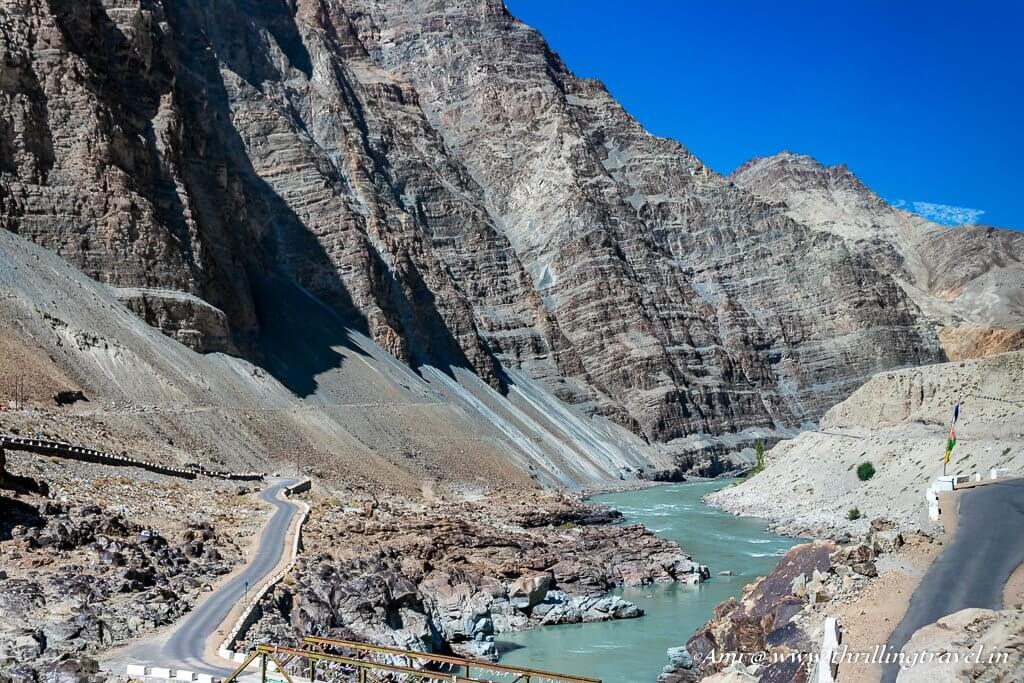
“We have come to Dah Village” – announced our driver. Surprised at the single home, I looked at him. He pointed to another home far below and said “That is where the other homes are. The car cannot go there, so you will need to walk it down“.
Meeting our first resident of Dah Village
With no one in sight but just a small home far below, we had no option but to embark on the zigzag trek downhill. To be honest, I expected a cluster of homes buzzing with activity – similar to the other villages that I had seen. Possibly like the Corn Village of Uttarakhand. However, this was quite remote. As we approached the lone home, we met our first resident Aryan.
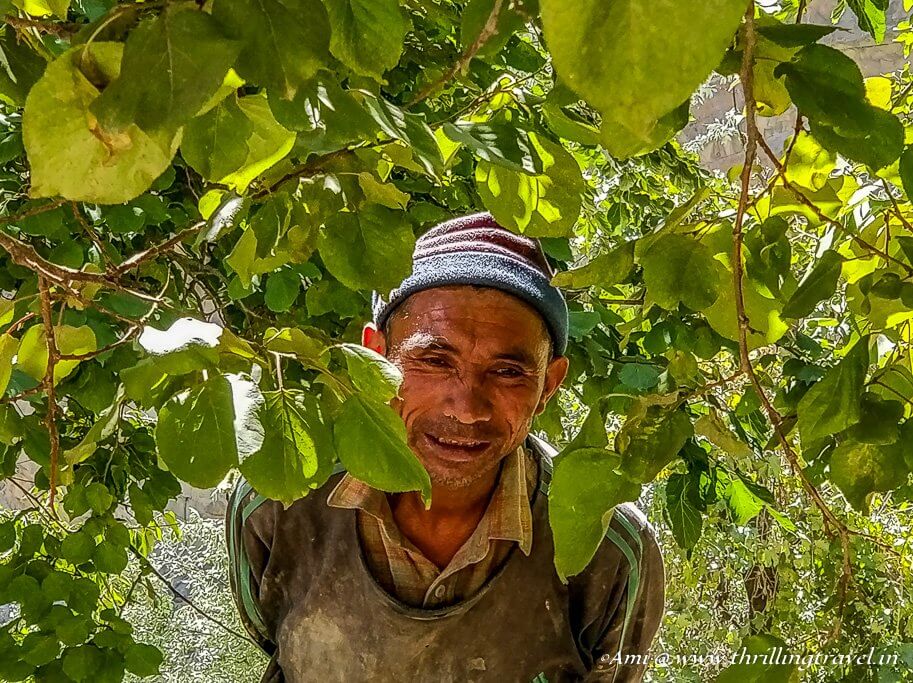
He responded with his toothless grin to my Ladakhi greeting “Julley” and then, the conversation turned alien. He spoke only in the Brokpa Language called Brokskat or Minaro. Gesture language being universal, I managed to understand that his home was down by the stream and there was one more home just a little ahead. Using the same language, I sought his permission to click a picture for which he gave the cutest camera shy smile. 🙂
Chat over the Apricots

We walked on towards the first house, where two Aryan ladies were sorting out dried apricots. The older one broke into a smile when she saw us and offered us some of those Apricots. A perfect ice-breaker as we begun our chat with her. She wasn’t very comfortable with Hindi but was able to reply back in bits and pieces.

The lady had left her entire life in that village. She was beginning to get used to visitors of late, people from Leh who came to witness their dance. The furthest that she had been to was to Khaltse. She told us that her kids were on the farm while the children around the village were at school. She pointed out to the place where our bus had dropped us to indicate the location of the school. It was while talking to her, that I met Sonam Tundup – who became our official source of the tale of the lost Aryan village of Dah Hanu.
Brokpa Food & Life

Sonam Tundup is an Aryan farmer in Dah village. A true Aryan – as he proclaimed, his forefathers – including great grandfather are from the Dahanu Valley. Speaking fluent Hindi, he told us all that we wanted to know about their life in Dah. The population of the Aryan villages – all five included would not exceed 1000. There was one leader or sarpanch of all these villages. This particular village had around 100 odd men and 75 women. Most people around the villages know each other pretty well as they tend to marry within themselves.
It is a norm to only marry an Aryan as they believe in racial purity, However, with education creeping in and doors opening out to the youngsters, a lot of the newer lot have married outside. They are not easily accepted back into the village and hence, have made homes in places like Leh. Polygamy or multiple marriages are very common.
I had heard rumors about how German women came to the Dahanu village in Ladakh to conceive - all in a bid to get a pure Aryan bloodline. Curious about Pregnancy tourism, we asked Sonam. He smiled and said - "There were some ladies who came but now, they no longer come". Beyond this, he was quite shy to speak any more.
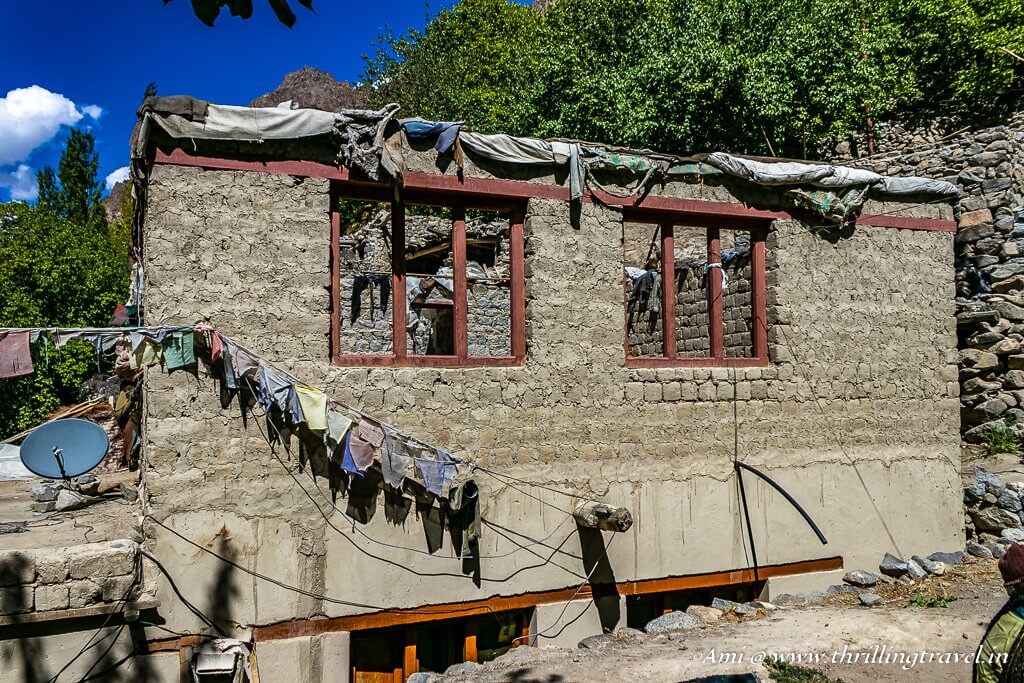
The typical occupation of the Aryan men is farming – largely apricot. They not only sell apricot in all forms but make apricot jam as well. The farmers also, rear goat, cow and yaks. Their normal food includes Yak milk along with Wheat (referred to as Papa) and vegetables. The newer generation of Aryans has started serving the Indian army and are posted in the nearby camps.

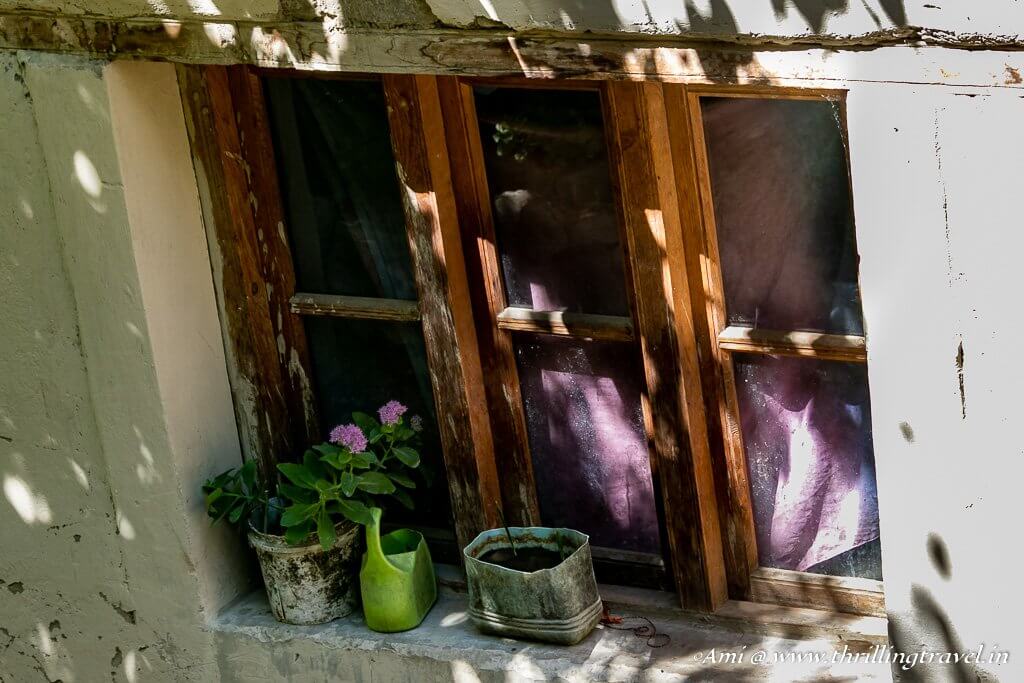


To endure the harsh weather, they used to build stone homes earlier. The toilets were just slabs with a low roof. However, with a little modernization creeping in, they now have regular homes. They have limited electricity and highly depend on solar energy, They also, have a gas connection. Earlier food was cooked on fire hearths, some of which you can still spot around the houses.

Aryan Festivals of Dahanu Village in Ladakh
Earlier the Aryans did stone worship. Sonam mentioned that his forefathers had rituals around those. There are no written accounts or literature documenting those lost years. Over time, the stories around them seemed to have dimmed as the Aryans now follow Buddhism. However, they still have some of their own festivals.
Bonona festival that takes place in September. This is their harvest festival which they celebrate with their traditional dances. The dances were referred to as Devta dances where the performers dress up like God. There are songs for 3 – 4 days after which the festival concludes.
A Brokpa language festival is now celebrated in August. This is done by the authorities to promote the Dah Hanu tourism and is not really an Aryan festival. The villagers prepare well in advance for the festival, where they practice their traditional dances and songs. On the day of the festival, they dress up in their traditional attire and perform at a single place for the visitors who come in from Leh.
Besides these, they have feasts to celebrate weddings and a child’s birth. The Aryan festivals are an occasion for all five villages to come together.
A traditional Aryan attire

Speaking of traditional Aryan attire, Sonam said that they have elaborate headgears. He called them Tepi and said that they are decorated with local flowers that are sewn together. The women wear their hair in long plaits and have long earrings and necklaces. Given the harsh weather, their coats are made of sheepskin and wool. These are brightly colored as they love all that is vibrant.
Escape during the Indo-Pak War
One of the key targets of the Kargil war was the Dahanu village in Ladakh. They had to be evacuated and moved to Khaltse for safety. The army occupied their homes in a bid to protect them from harm. Sonam said that they all volunteered with the army and helped them with their provisions. Minus one death, all of them were safe and alive. The one death was of a lady who refused to move and was killed in a bomb explosion.
Highly recommended read: Kargil war Memorial in Drass
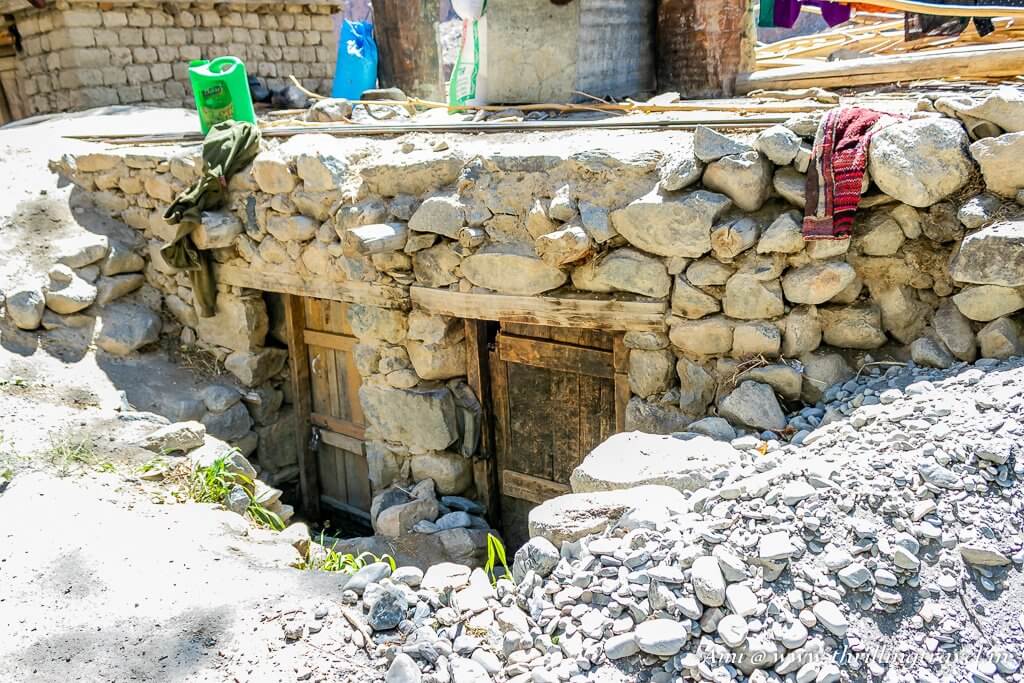
Post the war, the Government helped them with their house repairs and other needs. “Things have been better lately, with the Government setting up a primary school in Dah and an advanced one in Khaltse. Our kids now are getting ready for the modern world.” – declared the man who knew Shahrukh Khan and Rajnikanth. 🙂 With a brief fold of hands, a Thank you and a Julley, we turned back to head home.
A Tea Invitation by the Aryan Lady

I meandered a bit towards the other home where I met another resident. He was in a hurry and hence, I did not indulge in a hearty conversation. However, he did pose for a picture before moving up. I even met a Jawan (Soldier) from the Indian Army in Dah. He was from Bengal but spent time helping these villagers – a thing that I guess all the nearby Army camps do. As I reached the place where the bus dropped us, I met this delightful lady.

Over 70 years old, she gave me the brightest smile ever. She pointed to a large mansion and said she was an Aryan who lived there with her husband. Her kids were all grown up and in Leh. Quite chatty, she invited me for a cup of tea so that she could show her jewelry. Very apologetic about her non-traditional appearance, she said that she had just washed her hair and hence, was not prepared. She said she had just removed her plaits and her long earrings.

I assured her that I would be back some other time for the tea. With her permission, I took her picture which I retained, only after she was satisfied with the shot. I regretted not having had that tea for I know she would have regaled me with many more stories of her master race – the Aryans.

How to visit the Aryan Village in Dahanu, Ladakh?
- The Aryan villages are quite remote and located near the India-Pakistan border. You can get to the Dah Village only by road from Kargil or Leh (165 km). There are plenty of cab services in Leh that you can hire.
- Leh is the closest airport. There are a lot of regular flights to Leh from Delhi and Mumbai.
Travel Tips
- You need an Inner Line Permit to visit Dahanu Village in Ladakh. This will need to be shown at Khaltse. You can refer to this Ladakh Travel Guide for information on how to get this Inner Line Permit.
- The villages are quite remote and there is no restaurant or restroom around. In fact, you will not get any after Khaltse.
- The villagers are very simple people and only a few of them can speak Hindi. Remember to be polite to them and seek their permission before clicking their pictures.
- Apricots are available in plenty and being simple people, they offer you a handful of these to take home. It is only polite to pay them for the crop as this is their livelihood. Sonam offered us bundles and we insisted on paying him. He just charged us INR 200 for half a kg as against 500 that you pay for the same crop in Leh.
- It is a good idea to go around their festival time so that you can witness their traditions in full glory.
- Please be mindful of their personal spaces when clicking their pictures.
- There is a fair amount of trekking you will need to do when you visit Dah Village. Wear flat shoes or trekking shoes for the same.
- It is always cold here. Make sure you are well bundled with a jacket.
- The light for photography can get really harsh here. Make sure you have your white balance and ISO settings geared for it.
- I recommend this as a day trip from Lamayuru or Leh as there are no hotels to stay close by. You could even opt for a Stay in Alchi

Disclaimer: This article includes affiliate links. This means that at no cost to you, I will receive a small commission if you purchase through my link. Thank you for supporting me with this.
Popularly referred to as a Restless Ball of Energy. My Mom refuses to entertain my complaints about my equally restless daughter & assures my husband that I was born with a travel bug.
I am a Post-Graduate in Marketing by qualification and a travel blogger by passion. Besides travel, I enjoy photography and if you don’t find me at my desk, I would be out playing badminton or swimming or just running. I believe in planning for every long weekend through the year. And when I cannot travel physically, I travel virtually through this travel blog. My travel stories have also, got published on various websites and magazines including BBC Travel, Lonely Planet India and Jetwings. I have recently published my first book – When Places Come Alive – a collection of stories that are based on legends, landscapes, art and culture of a place which is available in both ebook and paperback format.

Wow, what an adventure. Your photos are awesome, especially the portraits of the villagers, so lovely. Would love to visit this region of India.
Thanks Laura. I hope you can meet them for yourself
This post is really gem.I have heard about them and read it;reading this makes me smile and cry at the same time.Tourism should reach here to promote this community and to support their livelihood.Loved the Post.
Thank you Mayuri. At the moment, the tourism is limited but then, I can see that whatever it is, it is a little exploiting. They are made to entertain the tourists but am not sure they get much out of it. I hope that people change that and get a little more sensitive to the people living here.
What a lovely place to visit. I’m honestly not sure whether I’d vote for more tourism in somewhere that is so traditional. It raises a bigger question about whether the kind of changes that the modern world brings are progress or not
I completely agree with you on this. I think they need a little more human conditions rather than pure-play tourism. Possibly more of cottage industry might help.
Hi
I’m from sanit (Dah, Baima) Aryan valley Ladakh
Hello to you too. I hope you liked the article.
Loved this post about a supposedly superior race that even sparked pregnancy tourism for a time!
Thanks Carol. Glad you liked it.
Ami this is fascinating. I do see some white-person-features in these folks, I reckon. I just love celebrating our differences and similarities, because we are all One, anyway.
Indeed. We are all one and it is these colorful differences that make life so vibrant.
What an amazing trip, Ami! I love your interaction with the locals and having them share stories with you. 🙂 So interesting to know about their traditions and customs. I’m pretty sure their Aryan Festivals are as colourful and full of history as their village is!
It was so much fun Marvi. I am glad that I managed to meet them and speak to them. Thanks for stopping by
We did Ladakh a few years back and were left smitten by the beautiful untouched landscapes and tranquil surroundings. But we definitely missed a lot of places Dahanu Village is one of them. The Aryan festivals of the village sounds fascinating must be one of its kind of experience.
The Aryan festivals do sound different and I hope that I get to see one of them at least. Dahanu is offbeat in the offbeat. Takes a bit of an effort to get here. Hope you can make it the next time.
What a unique experience! I love that such villages are so well kept and yet are still opening to the rest of the world instead of staying completely cut off. I wish you could have stayed for tea with the last lady. I’m sure she had TONS of stories and wisdom to share with you! Next time for sure 🙂
Ah yes, I wish I had stayed on too for tea. However, time was the enemy. Hope she remembers me when I visit again (if ever!)
I definitely got goosebumps while reading through your article. Oh my God, how much I like lost kingdoms, lost cities, and lost tribes. And you got me so interested right at the beginning. Would love to visit the Dahanu and see this for myself. Can totally relate to your excitement. Pinning this for future travels!
I am sure you will love visiting it. There are such small nuances that are waiting to be discovered here.
It is fascinating to learn about this isolated village of a culture I never knew existed! It is so interesting to see how they live, and to see how the exchanges with the outside world will change their culture. Thanks for sharing this!
Thanks Claire. I totally enjoyed the stories they had to tell. So much novelty and heritage.
Fascinating that the descendants of King Alexander are still living as a cohesive community in Ladakh. What a wonderful experience to visit the cluster of villages that form the community. The visit looks delightful, with your opportunity to meet the inhabitants of the village, and enjoy the village, culture and landscape.
Thanks Kavita. I loved stumbling into them and listening to their stories. And yes, the landscape was a complete bonus
Now thats the ‘something new’ lesson I have learnt today. There are still descendants from King Alexander and they are living in this isolated village. That bit I did find interesting. What was more enjoyable for you, experiencing the culture of the locals there or seeing the truly amazing landscape?
Thanks Danik. I think you cannot separate the two – the landscape totally merges with their life and culture. And I loved em both.
Aryan is so amazing and your post just brought back so many nice memories. I visited last year and had such an amazing time. I come from Macedonia btw (the land of Alexander the Great) and this was a place I definitely wasn’t going to miss. The trip was nothing short of spectacular.
Now you have got me with that Macedonia heritage. I sure would want to visit there to figure more so that I can compare my visit to this village with the origins. And yes, good luck to you in terms of planning a trip here.
This is an amazing trip you had and experience their genuine lifestyle. Thank you for sharing us this very remarkable experience and now we are educated of this place and the people.
Where are you heading next?
Thank you Blair. This was a unique experience and as to where I am heading next….fingers crossed. Somewhere soon!
Haven’t heard about Ladakh yet, ’till now. Good thing I came to visit your blog. I wish you could have tried the Aryan lady’s tea at least to share it with us. Anyway, your post is surely interesting, now I started to wonder about Aryan people. Looking forward to more of this.
It is an offbeat part of India and so not surprising that you are not aware of it. I think you should visit here and explore the surreal landscapes. Cheers
What a lovely encounter with the old lady who invited you for tea. It’s moments like that on my travels that I treasure. It’s an experience that money just can’t buy and that makes it such a special occasion.
I agree…such moments are what makes travel interesting.
Interacting with the locals in these remote villages and peeking into their (different) lives would have left an indelible impression on your mind, i am sure. India has so much diversity, sometimes it blows one’s mind. We are truly blessed with so many riches.
I second that. We are blessed to have such a rich heritage and diversity
What an amazing place to visit – I didn’t realise there were still enclaves of the Aryan bloodline in existence. While it’s amazing I get to see the Dahanu through your eyes, I kind of hope that tourism and the modern world doesn’t catch up with them too soon. Ladakh is so spectacularly beautiful – especially the river running through the gorge like that.
This is a place where you need some responsible tourism so that it does not get spoilt. I hope people figure that out soon. At least I hope my readers can make a difference.
What an interesting visit with the Aryan descendants in India. It seems so strange that they’ve managed to keep their population as pure as possible and stick to their old ways. I wish you’d stayed for tea because who knows what other stories you would have learned. That’s a bit strange about the German Pregnancy migration. What a welcoming people.
Thanks Annick. I too, wished I could have stayed for tea but well, time as always had me rushing. Nonetheless, a good interaction it was.
Very interesting post, it was really good to know their origin,culture and lifestyle. It was known to me that Alexander left some clansmen here but did not have much info what happened to them later.
Captures are beautiful, loved the houses and the doors .
Thanks Jyotirmoy. These guys are so proud of their origin and totally love sharing the tales. I hope you can visit the place too.
Beautiful post about a topic that is unknown to many (atleast me). Your pictures speak a thousand words and i especially loce the portraits. I did not know about this part of Alexander’s history of conquering the world
Thank you Sinjana. Glad you enjoyed the story. I hope you get to see it for yourself. The whole Alexander lineage does make it interesting.
Thanks for sharing your tour experience of Dahanu village of Ladakh. I read your post, I really appreciate from your post, your post is very beneficial for every reader including me. Your pictures are saying everything you had a great time in Ladakh.
Thank you. Glad you enjoyed it all.
Thanks for sharing. Very deep, the photos are incredible, it creates a perfect authenticity of the village. I haven’t been to India yet but if I go I might check this place. Great to know the travel tips.
Thanks Diana. I hope you visit India soon and when you do, make sure you head to Ladakh. It will give you a different picture of the country.
It has always been one of my dream place to visit in Ladakh since childhood. Your info is really helpful about knowing these aryans people. By reading your story and the way you describe them with pictures feels like we met them in reality. So thnx a lot for sharing your glorious story and experience with us. But I have few questions in mind about visiting this place if you don’t mind answering them.
1. What are the requirements to get the inner line permit to visit these villages?
2. Is there any limit of members visiting this place at a time?
3. What is the best way or route to visit these villages in short period of time?
Hi there, the answers to these questions are already in the post. Do check out the last section.
wow and great research.. thanks for sharing the useful information. From my point of view i didn’t knew that there is such kind of village still exist. Keep it up..
It was a lovely visit indeed. One that I will treasure for a long time. Next time you are in Leh, try and get here.
Thanks for sharing your experience. We’re planning to visit there. Can we stay at Dah? Can you let me know the when they celebrate the festival? Then we can plan accordingly. Thanks again for sharing your such experience which really help us to plan our trip.
Hey Abhik, I think you missed my mention of the time and the stay options here. Have a read again and am sure you will stumble upon the relevant information.
If anyone have willing to visit do contact with me…. I’m from that village…
That is so nice to know. I will be sending you a mail soon 🙂
Hey AMI,
Thanks for sharing this blog with us because i love the ride of Ladakh. But know i came to know about the famous and historic place of Ladakh not only that I even don’t know that Apricot was from Ladakh. Thank you for sharing this with us.
Glad to be of help. Hope you can visit it the next time.
lovely place to visit
Thanks. It sure was
well narrated!
Thank you
Looks like such a great experience Ami! Its good to know that one needs a special permit to visit this part of Ladakh, the village looks really quaint and I can imagine how simple their lifestyles must be out there and how’humble people living in such places are. It’s like the chaos of the city life hasn’t touched them and they live in another world and it really is beautiful. Very kind of them to offer apricots and not even expect you to pay them in return! I can imagine how disconnected they must be from the rest of the world when you say one needs to trek quite a bit to get to these villages!
I am so glad to have found this place for the very reasons you have picked from the post. It was a very invigorating experience.
The local peoples are very helpful and sweet
No doubt about that. They are the most humble
Hi Ami,
Thanks for sharing. The photos are incredible, it creates a perfect authenticity of the village life.
You are well qualified with your words and expression.
Enjoyed reading it.
That feels so good to hear. Am so happy that you like the post.
Nice read
Thanks Srini.
I recently visited Kashmir and ever since planning a trip to Ladakh. This is a fascinating and informative article about the Aryans of Dahanu village. Thanks a lot for the tips at the end. It is good that there is an inner line permit to visit their village or else they would have had to suffer the brunt of overtourism. I enjoyed reading their story through your words. Thanks
Thanks Ashley. Glad you found the post interesting.
What an interesting storyteller you are. Loved it. wish someday I could meet you. Fan of your pen game and imagery thinking. crashed here after seeing reel in Instagram. Debate over last aryan bloodline exist in ladakh. Thanks a ton for such neat information.
Thank you so much Sumit.
You clicked so many nice pictures and thank you so much for posting this, I liked it.
Thank you so much.
I appreciate you sharing this blog with us, as I have a great fondness for the journey through Ladakh. I have now learned about the renowned and historic sites in Ladakh, and I was unaware that apricots originated from this region. Thank you for providing this information.
Glad to help. I hope you discover more such amazing things in Ladakh. Cheers
Thanks for sharing this wonderful tour experience guide with us. I really glad to read this amazing experience.
Thank you for the lovely compliment